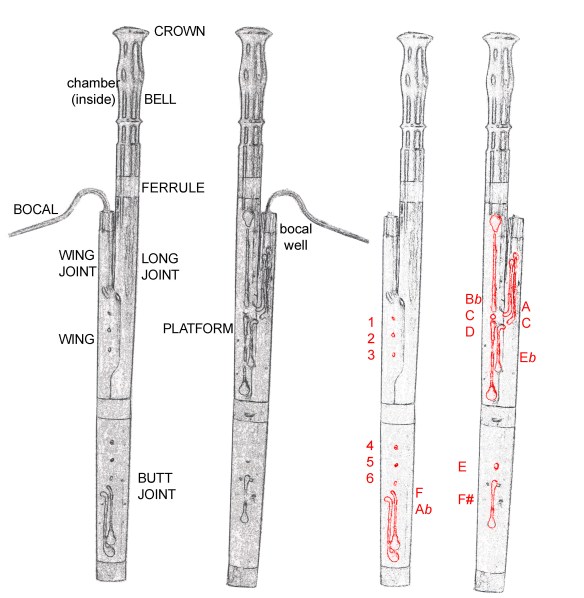Glossary
A small-sized-bassoon is classified as either a ‘fagottino’—an instrument sounding one octave higher than the full-sized bassoon—or a ‘tenoroon’, a transposing instrument normally either in G or F. The glossary and bassoon terminology used by the fagottino and tenoroon research team is based on those found in: James Kopp, The Bassoon, New Haven: Yale University Press 2012; Phillip Young, 4900 Historical Woodwind Instruments, London: Tony Bingham 1993.
General Terminology:
- Full-sized bassoon: non-transposing instrument in C
- Small-sized bassoon: general term including both fagottino and tenoroon
- Fagottino: small-sized bassoon in C, sounding one octave higher than the full-sized bassoon
- Tenoroon: transposing small-sized bassoon not in C, but usually found in G, F and rarely, Eb
- Tenoroon in G: small-sized bassoon transposing C to sounding G
- Tenoroon in F: small-sized bassoon transposing C to sounding F
Compass Points for Orientation:
- North: upper part of instrument
- South: lower part of instrument
- Front: part of instrument opposite to player
- Back: part of instrument that faces player
Parts of the Basson:
Bell
- Crown: decorative and protective ring at the top of bell
- Ferrule: protective brass bands situated on bell, wing joint, and at both ends of butt joint
- Reverse taper bore: bore becomes smaller in diameter toward the open end of bell
- Bell chamber: hollowed section inside bell toward the opening
- Vent hole: open hole in bell not operated by a key
Long joint
- Platform: flat band lengthways on long joint where D and Bb keys, together with C tone hole, are placed
Wing joint
- Wing: flap holding three angled tone holes of wing joint
- Under-cutting: shaping which is made to tone holes where they join main bore
- Tenon: part of joint that is inserted into into socket; situated on long joint, wing joint and bocal
- Socket: inner part of joint where tenon fits; situated in bell, wing joint and butt joint
- Bocal well: inner part of wing joint where bocal fits
Bocal
- Tenon: part of bocal inserted in wing joint
Butt joint
- Small bore: bore with smaller diameter of the two
- Big bore: bore with larger diameter of the two
- Septum: wood separating two bores
- Window: connection between two bores at bottom of instrument
- Cork: cork stopper found at end of two bores, below window
Keys and Key-Mounting Terminology:
Makers generally name keys and tone holes of wind instruments according to the sound produced when the hole is open. Performers name the keys and tone holes according to the sound they produce when they are operated. The fagottino and tenoroon project follows the most common way of denominating the keys used by performers.
Key-mounting
- Staple: a type of mount for key with an inverted U-form with a metal wire passing through the mounting hole
- Saddle: a metal U-shaped channel screwed into the wood
- Pillars: metal pieces to attach keys
- Recessed into body: a channel cut into the wood where the key rests
Key parts
- Touch: part of key in contact with finger
- Shank: link between touch and flap
- Flap: part of key covering tone hole
Key and tone hole names
- Tone holes in contact with fingers, named as: 1, 2, 3 (left hand) / 4, 5, 6 (right hand)
- Long joint keys and holes: D, C (referring to the open tone hole) Bb. An Eb–key might be located in the back, to be operated by the left thumb (found on French, British, Viennese bassoons), or in the front, operated by the little finger (German bassoons)
- Wing joint keys: named after the note they produce: A, C, D. Ordered according to the touch of key, from south to north, depending on different regional systems
- Butt joint keys and holes:
- Back view: E tone hole and F# key. C# key may be located in front/back
- Front view: F key and Ab key. Sometimes also a Bb key
- Player’s fingerings: LT (left thumb), L1 (left index finger), L2 (left second finger), L3 (left ring finger), L4 (left little finger), and RT, R1, R2, R3, R4, similarly
